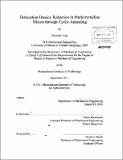Dislocation density reduction in multicrystalline silicon through cyclic annealing
Author(s)
Vogl, Michelle (Michelle Lynn)
DownloadFull printable version (11.04Mb)
Other Contributors
Massachusetts Institute of Technology. Dept. of Mechanical Engineering.
Advisor
Tonio Buonassisi.
Terms of use
Metadata
Show full item recordAbstract
Multicrystalline silicon solar cells are an important renewable energy technology that have the potential to provide the world with much of its energy. While they are relatively inexpensive, their efficiency is limited by material defects, and in particular by dislocations. Reducing dislocation densities in multicrystalline silicon solar cells could greatly increase their efficiency while only marginally increasing their manufacturing cost, making solar energy much more affordable. Previous studies have shown that applying stress during high temperature annealing can reduce dislocation densities in multicrystalline silicon. One way to apply stress to blocks of silicon is through cyclic annealing. In this work, small blocks of multicrystalline silicon were subjected to thermal cycling at high temperatures. The stress levels induced by the thermal cycling were modeled using finite element analysis (FEA) on Abaqus CAE and compared to the dislocation density reductions observed in the lab. As too low of stress will have no effect on dislocation density reduction and too high of stress will cause dislocations to multiply, it is important to find the proper intermediate stress level for dislocation density reduction. By comparing the dislocation density reductions observed in the lab to the stress levels predicted by the FEA modeling, this intermediate stress level is determined.
Description
Thesis (S.M.)--Massachusetts Institute of Technology, Dept. of Mechanical Engineering, 2011. Cataloged from PDF version of thesis. Includes bibliographical references (p. 77-78).
Date issued
2011Department
Massachusetts Institute of Technology. Department of Mechanical EngineeringPublisher
Massachusetts Institute of Technology
Keywords
Mechanical Engineering.